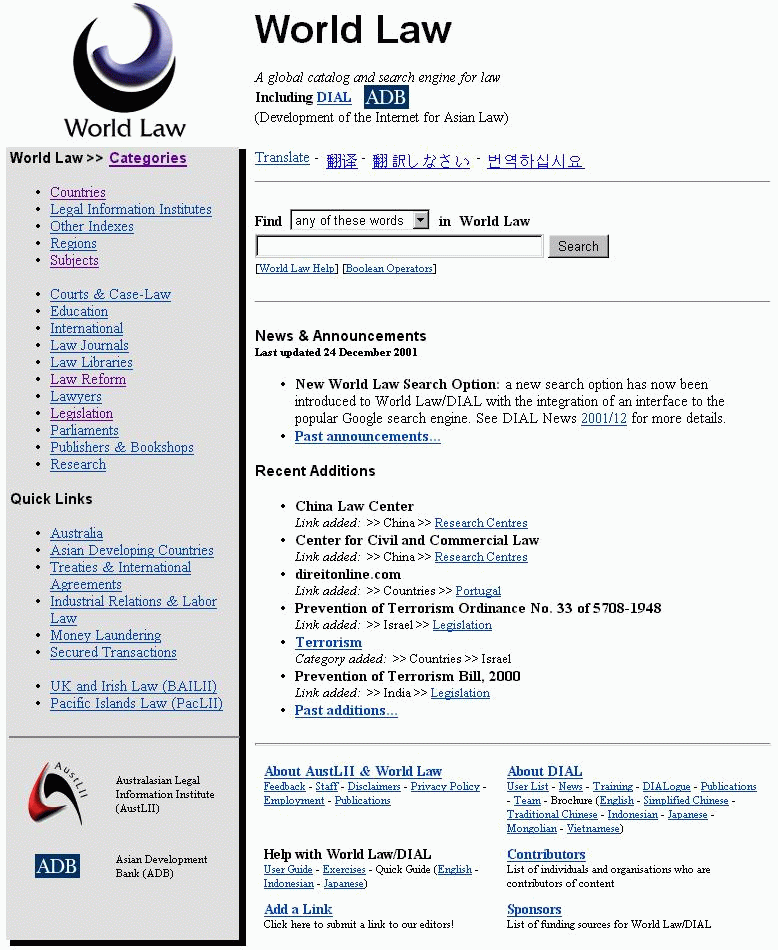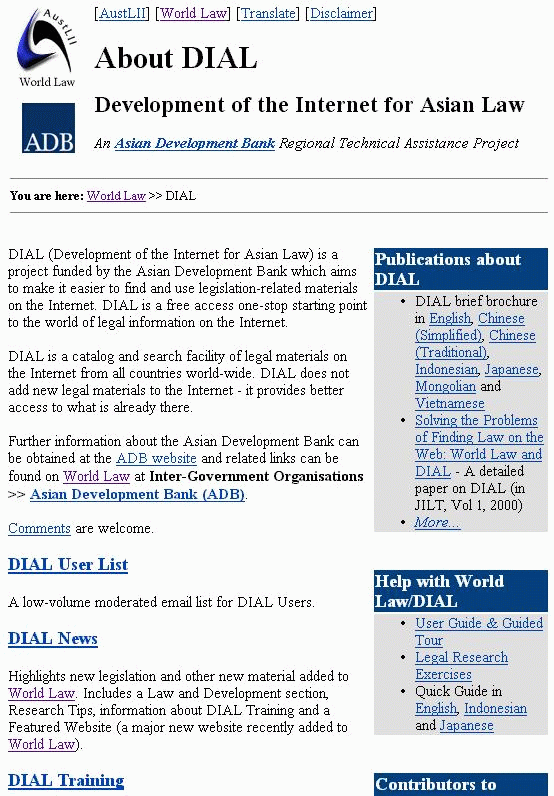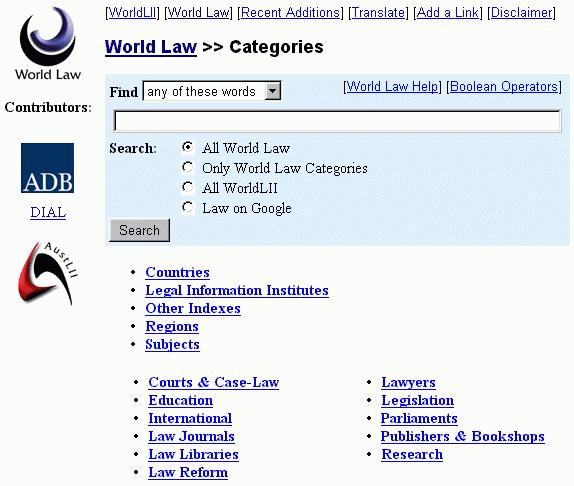
The World Law homepage <http://www.austlii.edu.au/links/> provides information about World Law, news items, new links and categories and provides shortcuts to the main categories of World Law. Chinese, Japanese and Korean translation is also available from this page as well as other languages at [Translate].

About DIAL <http://www.austlii.edu.au/dial/>, shown below, provides information about the DIAL project including an email list, newsletter, training, publications and other matters.

• Go to the About DIAL page.
• Under DIAL Publications look at the Mongolian language version of the DIAL brochure (or one in another language you can speak). Then use the Back command on your browser to come back to About DIAL.
• Under DIAL Training, look at one of the photos of training sessions, then come back to About DIAL.
• Note there are 3 links to the World Law homepage from the About DIAL page. Use one of the links to go to the World Law homepage then come back to About DIAL.
• Under the heading DIAL News, look at some of the back issues in the archive list.
The starting point in the catalog for both World Law and DIAL is the Categories page. See below. You can get back to Categories from any page in the catalog using the Back button on your browser or by using the navigation path displayed on each page.

We use the following terminology:
The top subcategories of the Categories page are as follows:
The middle subcategories of the Categories page are as follows:
The essential point to understand about this catalog is that most websites are indexed in at least three ways:
This means that there is usually more than one way to browse to the information you are looking for.
• Go to the Categories page.
• Find United Kingdom legislation concerning bankruptcy and insolvency first by starting with Countries, then go to United Kingdom and then Subjects. Now go back to Categories.
• Now find the same United Kingdom legislation starting with By Subject, then Insolvency & Bankruptcy, then United Kingdom. Now go back to Categories.
• Find the homepage of the World Trade Organisation (WTO) first by starting at International and then going to Inter-Government Organisations, and then to the subcategory for the WTO. Now go back to Categories.
• Now find the same WTO homepage by starting with Subjects, then going to International Trade and then International Organisations & Bodies.
• Later in the tutorial you will learn another way of finding these resources - by searching the catalog.
Catalog pages have a three-part structure. The content of the three parts is consistent, but has some variations from page to page in order to make the pages easier to use, and depending on whether the page concerned is a Countries page or a Subjects page.
The top and middle divisions are essentially for navigation around the catalog, and the bottom division is where the content of the catalog is found.
• New Zealand - a country page with the subjects in the middle.
• Privatisation - a subject page with subcategories by source or type at the top, including a By Country subcategory, two See Also @ links (to related subjects) and Stored Searches over various parts of the system.
• The Categories >> Law Reform page lists countries which have law reform agencies in its middle section, rather than on a separate By Country page, because that is the most important information users are looking for on this page.
Every page in the catalog lists at the top of the page its hierarchical location in the catalog. In other words, it lists the hierarchy of categories and subcategories (starting with >> Categories) that give it its position in the catalog. Click on the name of any category in the hierarchy to go back to the page in the catalog for that category.
In the example below, if you click on the word Countries, you go to the World Law >> Categories >> Countries page (listing all countries in the world). If you click on United States of America you go to the page World Law >> Categories >> Countries >> United States of America, the starting page for the USA.
You can always get back to the start of the catalog by clicking on Categories.
If you are in the Categories part of the catalog and you want to get to a particular country page (eg Viet Nam), click on Categories then Countries and then select Viet Nam.
• Go to the page for United States of America >> Legislation >> State Legislation
• First, go to the page for France by first clicking on >> Countries >> and then going to the page for France. Then come back to the United States State Legislation
• Now click on >> United States of America >> and check which US Law Reform agencies have web pages.
On many pages, links to some or all subcategories of the catalog will be followed by the @ symbol. The use of the @ symbol means that this is a cross-reference to another part of the category hierarchy. When you go to a cross-reference, you go to a different part of the hierarchy, from the one you are now in, and the hierarchy displayed at the top of the page will change from where you were. In order to get back to the page you came from, you must use the Back button in your browser, you cannot use the browsing hierarchy to do so.
This occurs in two situations, which in a library catalog or book index would often be called See and See Also. In World Law, the difference between the two uses of @ relates to the scope of searches. These differences are explained further under Chapter 3. Searching, under the subheading Limiting search scope - difference between ‘@’ and ‘See also @’.
At the top of each catalog page, there is the button
bar:
The buttons mean:
|
[WorldLII] |
Links to the WorldLII homepage |
|
[World Law] |
Links to the World Law homepage |
|
[Recent Additions] |
Lists new additions to the catalog. |
|
[Translate] |
Translates this and following pages into any of 5 European languages (uses Alta Vista’s Systran). |
|
[Add a Link] |
Provides a form for users to suggest new links. |
|
[Disclaimer] |
AustLII cannot take responsibility for sites linked to World Law |

Under the search window on each page is the button bar:
|
[World Law Help] |
The latest version of this User Guide. |
|
[Boolean operators] |
Details on how to use search connectors. |
• The [Recent Additions] button at the top of any page shows the same list of new additions to World Law/DIAL. See what is in [Recent Additions] at the moment.
• Go to the Categories page and click on the [Translate] button at the top of the page. Choose a language to translate the page into.
• Go to the France >> Legislation page and look at the table of contents of the site called Legifrance (it is in French). Come back to the France >> Legislation page, and click on the [Translate] button. Choose a translation from French to English. Now go to the Legifrance site again. This time the table of contents should be in reasonably understandable English.
Sites are listed in World Law/DIAL if they appear to be a serious attempt to provide useful legal information. Most useful law sites on the web are unofficial sites and do not provide any guarantee that the information they provide is official or up-to-date. In addition, the content on websites changes constantly, making evaluations very difficult.
There is a [Disclaimer] button on the top of every World Law page that explains that we cannot take responsibility for sites linked to from World Law/DIAL.
The best way to make your own assessment of how reliable a website may be is to go to the homepage of the site and read information about who provides it. See the Guided Tour below for ways to do this.
1.A link on the Categories >> Countries >> Canada >> Elections page - Canada Elections Act - takes you directly to the page http://www.elections.ca/content.asp?section=loi&document=index&dir=ref&lang=e&textonly=false
How can you assess the reliability of this web site? Go to the front page of the site by deleting content.asp?section=loi&document=index&dir=ref&lang=e&textonly=false from the page address (URL) in the location window, so that it reads http://www.elections.ca/ and press ENTER. You can now see who operates this site and judge its reliability.
Sometimes when you go to a link to a web page listed in World Law’s catalog or found by a World Law search, the page will not be available and you get a message like ‘Not Found - The requested URL was not found on this server or Error 404’.
Sometimes this will be because the page no longer exists, but very often it is simply because the site operators have changed the site since the World Law catalog was last updated, and the page has been moved. It is still there, but you have to find it. The best way to find a moved page is to delete part of the page address, back to the next slash (/), and see if that gives you part of the site which does have content and allows you to find the moved page. See some examples in the Guided Tour.
• Go to World Law >> Categories >> Countries >> Ireland >> Cyberspace and click on ‘Framework for Ireland’s Policy on Cryptography and Electronic Signatures’. You get a ‘The page cannot be found’ message. In order to find this document you can follow the directions to the homepage of the Department of Public Enterprise and search from here for the document.
• Go to Categories >> International >> Treaties & International Agreements >> Multi-National Collections >> UN Treaties Collections and click on ‘Single Convention on Narcotic Drugs of 1961 and that Convention as amended by the 1972 Protocol: Monthly Status of Treaty Adherence’. You get a ‘404: Not Found’ message. Delete ‘document_1999-10-04_1.html’ from the location window in the browser to go to the homepage of the United Nations Office for Drug Control and Crime Prevention (ODCCP) and browse from here for the convention by clicking on ‘Treaty and Legal Affairs’ and then click on ‘UN Treaties and Resolutions’. Note that the link to the Convention is there but the information is no longer located on the ODCCP server but on a separate website.